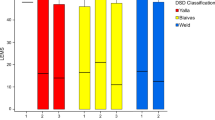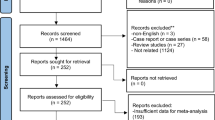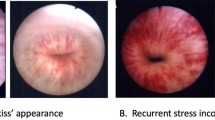Abstract
Detrusor–external sphincter dyssynergia (DSD) is a debilitating problem in patients with spinal cord injury. DSD carries a high risk of complications, and even life expectancy can be affected. The mainstay of treatment is the use of antimuscarinic medication and catheterization, but in those for whom this is not possible external sphincterotomy has been the traditional management route. External sphincterotomy, however, is associated with significant risks, including hemorrhage, erectile dysfunction and the need for repeat procedures, and over the last decade alternatives have been investigated, such as urethral stents and botulinum toxin injection. We present a review of DSD, including the current management strategies and prospects for future treatment.
Key Points
-
Up to 50% of patients with untreated detrusor–external sphincter dyssynergia (DSD) can develop serious urologic complications
-
Videourodynamic studies provide diagnostic confirmation of DSD; a leak-point pressure of >40 cmH2O is predictive of upper urinary tract damage
-
The principles of DSD management are to reduce intravesical pressure and aid bladder emptying
-
A combination of antimuscarinic agents and clean, intermittent self-catheterization seems to be the simplest method of treatment, but might not be suitable for all patients with spinal cord injury
-
Historically, external sphincterotomy was the standard treatment, but may be associated with significant complications
-
Newer, minimally invasive techniques such as urethral stents and botulinum toxin treatment seem to be safe and efficacious, but long-term data are lacking
This is a preview of subscription content, access via your institution
Access options
Subscribe to this journal
Receive 12 print issues and online access
$209.00 per year
only $17.42 per issue
Buy this article
- Purchase on Springer Link
- Instant access to full article PDF
Prices may be subject to local taxes which are calculated during checkout
Similar content being viewed by others
References
Kraus JF et al. (1996) Epidemiology of spinal cord injury. In Principles of Spine Surgery, 41–56 (Eds Benzel EC et al.) New York: McGraw Hill
DeVivo et al. (1992) Trends in spinal cord injury demographics and treatment outcome between 1973 and 1986. Arch Phys Med Rehabil 73: 424–430
Frankel HL et al. (1998) Long-term survival in spinal cord injury: a fifty year investigation. Spinal Cord 36: 266–274
Blaivas JG et al. (1981) Detrusor–external sphincter dyssynergia. J Urol 125: 542–544
Hackler RH (1977) A 25-year prospective mortality study in the spinal cord injured patient: comparison with the long-term living paraplegic. J Urol 117: 486–488
Kim YH et al. (1998) Bladder leak point pressure: the measure for sphincterotomy success in spinal cord injured patients with external detrusor–sphincter dyssynergia. J Urol 159: 493–496
McGuire EJ et al. (1981) Prognostic value of urodynamic testing in myelodysplastic patients. J Urol 126: 205–209
Blaivas JG et al. (1981) Detrusor–external sphincter dyssynergia: a detailed electromyographic study. J Urol 125: 545–548
Yalla SV et al. (1977) Detrusor–urethral sphincter dyssynergia. J Urol 118: 1026–1029
Weld KJ et al. (2000) Clinical significance of detrusor sphincter dyssynergia type in patients with post-traumatic spinal cord injury. Urology 56: 565–569
Shaw PJR et al. (1990) Permanent external striated sphincter stents in patients with spinal injuries. Br J Urol 66: 297–302
Kim YH et al. (1997) The role of oxybutynin in spinal cord injured patients with indwelling catheters. J Urol 158: 2083–2086
Scarpero HM and Dmochowski RR (2003) Muscarinic receptors: what we know. Curr Urol Rep 4: 421–428
Yamanishi T et al. (2001) Which muscarinic receptor is important in the bladder? World J Urol 19: 299–306
Chancellor MB et al. (1993) Clinical effect of α-1 antagonism by terazosin on external and internal urinary sphincter function. J Am Paraplegia Soc 16: 207–214
Perkash I (1995) Efficacy and safety of terazosin to improve voiding in spinal cord injury patients. J Spinal Cord Med 18: 236–239
Bennett JK et al. (2000) Terazosin for vesicosphincter dyssynergia in spinal cord-injured male patients. Mol Urol 4: 415–420
Sahai A et al. (2005) Botulinum toxin for the treatment of lower urinary tract symptoms: a review. Neurourol Urodynam 24: 2–12
Smith C et al. (2003) Effect of botulinum toxin A on the autonomic nervous system of the rat lower urinary tract. J Urol 169: 1896–2000
Leippold T et al. (2003) Botulinum toxin as a new therapy option for voiding disorders: current state of the art. Eur Urol 44: 165–174
Dykstra DD et al. (1988) Effects of botulinum A toxin on detrusor–sphincter dyssynergia in spinal cord injury patients. J Urol 139: 919–922
Dykstra DD and Sidi A (1990) Treatment of detrusor–sphincter dyssynergia with botulinum A toxin: a double blind study. Arch Phys Med Rehabil 71: 24–26
Schurch B et al. (1996) Botulinum A toxin as a treatment of detrusor–sphincter dyssynergia: a prospective study in 24 spinal cord injury patients. J Urol 155: 1023–1029
Schurch B et al. (1997) Botulinum A toxin as a treatment of detrusor sphincter dyssynergia in patients with spinal cord injury: MRI controlled transperineal injections. J Neurol Neurosurg Psychiatr 63: 474–476
Wheeler JS Jr et al. (1998) Botulinum toxin injections for voiding dysfunction folllowing SCI. J Spinal Cord Med 21: 227–229
Petit H et al. (1999) Botulinum toxin A treatment for detrusor–sphincter dyssynergia in spinal cord disease. Spinal Cord 36: 91–94
Gallien P et al. (1998) Treatment of detrusor sphincter dyssynergia by transperineal injection of botulinum toxin. Arch Phys Med Rehabil 79: 715–717
de Seze M et al. (2002) Botulinum A toxin and detrusor sphincter dyssynergia: a double-blind lidocaine-controlled study in 13 patients with spinal cord disease. Eur Urol 42: 56–62
Angaut-Petit D et al. (1990) Terminal sprouting in mouse neuromuscular junctions poisoned with botulinum type A toxin: morphological and electrophysiological features. Neuroscience 37: 799–808
Mamas MA et al. (2001) Augmentation of nitric oxide to treat detrusor–external sphincter dyssynergia in spinal cord injury. Lancet 357: 1964–1967
Reitz A et al. (2004) Oral nitric oxide donors: a new pharmacological approach to detrusor–sphincter dyssynergia in spinal cord injured patients? Eur Urol 45: 516–520
Lindehall B et al. (2004) Complications of clean intermittent catheterization in boys and young males with neurogenic bladder dysfunction. J Urol 172: 1686–1688
Wyndaele JJ (2002) Complications of intermittent catheterization: their prevention and treatment. Spinal Cord 40: 536–541
Wyndaele JJ (2002) Intermittent catheterization: which is the optimal technique? Spinal Cord 40: 432–437
Ord J et al. (2003) Bladder management and risk of bladder stone formation in spinal cord injured patients. J Urol 170: 1734–1737
Groah SL et al. (2002) Excess risk of bladder cancer in spinal cord injury: evidence for an association between indwelling catheter use and bladder cancer. Arch Phys Med Rehabil 83: 346–351
Subramonian K et al. (2004) Bladder cancer in patients with spinal cord injuries. BJU Int 93: 739–743
Chancellor MB et al. (1993) Transurethral balloon dilation of the external urinary sphincter: effectiveness in spinal cord-injured men with detrusor–external urethral sphincter dyssynergia. Radiology 187: 557–560
Chancellor MB et al. (1994) Prospective comparison of external sphincter balloon dilatation and prosthesis placement with external sphincterotomy in spinal cord injured men. Arch Phys Med Rehabil 75: 297–305
McFarlane JP et al. (1997) Balloon dilatation of the external urethral sphincter in the treatment of detrusor sphincter dyssynergia. Spinal Cord 35: 96–98
Nambirajan T et al. (2005) Urethral stents for detrusor sphincter dyssynergia. BJU Int 95: 350–353
Milroy EJ et al. (1988) A new treatment for urethral strictures. Lancet 1: 1424–1427
Shaw PJ et al. (1990) Permanent external striated sphincter stents in patients with spinal injuries. Br J Urol 66: 297–302
McInerney PD et al. (1991) Permanent urethral stents for detrusor sphincter dyssynergia. Br J Urol 67: 291–294
Chancellor MB et al. (1993) Placement of a wire mesh prosthesis in the external urinary sphincter of men with spinal cord injuries. Radiology 187: 551–555
Rivas DA et al. (1994) Prospective comparison of external sphincter prosthesis placement and external sphincterotomy in men with spinal cord injury. J Endourol 8: 89–93
Chancellor MB et al. (1999) Long-term follow-up of the North American multicenter Urolume trial for the treatment of external detrusor–sphincter dyssynergia. J Urol 161: 1545–1550
Sauerwein D et al. (1995) Wallstents in patients with detrusor–sphincter dyssynergia. J Urol 154: 495–497
Hamid R et al. (2003) The mesh wallstent in the treatment of detrusor external sphincter dyssynergia in men with spinal cord injury: a 12-year follow-up. BJU Int 91: 51–53
Wilson TS et al. (2002) Urolume stents: lessons learned. J Urol 167: 2477–2480
Gajewski JB et al. (2000) Removal of Urolume endoprosthesis: experience of North American Study Group for detrusor–sphincter dyssynergia application. J Urol 163: 773–776
Guazzoni G et al. (1994) A modified prostatic Urolume wallstent for healthy patients with symptomatic benign prostatic hyperplasia: a European multicenter study. Urology 44: 364–370
Soni BM et al. (1994) Use of Memokath, a second generation urethral stent for relief of urinary retention in male spinal cord injured patients. Paraplegia 32: 480–488
Shah NC et al. (1997) Use of Memokath temporary urethral stent in treatment of detrusor–sphincter dyssynergia. J Endourol 11: 485–488
Low AI and McRae PJ (1998) Use of the Memokath for detrusor-sphincter dyssynergia after spinal cord injury—a cautionary tale. Spinal Cord 36: 39–44
Vaidyanathan S et al. (2002) Long-term result of Memokath urethral sphincter stent in spinal cord injury patients. BMC Urol 11: 12
Mehta SS and Tophill PR (2006) Memokath stents for the treatment of detrusor sphincter dyssynergia (DSD) in men with spinal cord injury: the Princess Royal Spinal Injuries Unit 10-year experience. Spinal Cord 44: 1–6
Ross JC et al. (1958) Resection of the external urethral sphincter in the paraplegic: preliminary report. J Urol 79: 742–746
Schellhammer PF et al. (1973) External sphincterotomy: an evaluation of 150 patients with neurogenic bladder. J Urol 110: 199–202
Catz A et al. (1997) The role of external sphincterotomy for patients with spinal cord lesions. Spinal Cord 35: 48–52
Fontaine E (1996) Reappraisal of endoscopic sphincterotomy for post-traumatic neurogenic bladder: a prospective study. J Urol 155: 277–280
Reynard JM et al. (2003) Sphincterotomy and the treatment of detrusor–sphincter dyssynergia: current status, future prospects. Spinal Cord 41: 1–11
Perkash I (1994) Laser sphincterotomy and ablation of the prostate using a sapphire chisel contact tip firing neodymium:YAG laser. J Urol 152: 2020–2024
Rivas DA et al. (1995) Contact neodymium:yttrium-aluminium-garnet laser ablation of the external sphincter in spinal cord injured men with detrusor sphincter dyssynergia. Urology 45: 1028–1031
Juan Garcia FJ et al. (1999) Intraurethral stent prosthesis in spinal cord injured patients with sphincter dyssynergia. Spinal Cord 37: 54–57
Author information
Authors and Affiliations
Corresponding author
Ethics declarations
Competing interests
The authors declare no competing financial interests.
Rights and permissions
About this article
Cite this article
Ahmed, H., Shergill, I., Arya, M. et al. Management of detrusor–external sphincter dyssynergia. Nat Rev Urol 3, 368–380 (2006). https://doi.org/10.1038/ncpuro0521
Received:
Accepted:
Issue Date:
DOI: https://doi.org/10.1038/ncpuro0521
This article is cited by
-
The Management of Urine Storage Dysfunction in the Neurological Patient
SN Comprehensive Clinical Medicine (2019)
-
Contemporary Treatment of Detrusor Sphincter Dyssynergia: a Systematic Review
Current Bladder Dysfunction Reports (2018)
-
Medical Causes of Overactive Bladder
Current Bladder Dysfunction Reports (2013)
-
Evaluation and Management of Outlet Obstruction in Women Without Anatomical Abnormalities on Physical Exam or Cystoscopy
Current Urology Reports (2012)
-
Botulinum toxin in paediatric urology: a systematic literature review
Pediatric Surgery International (2009)



